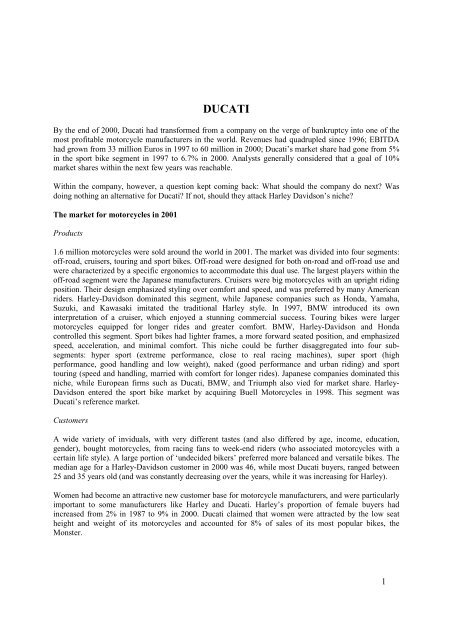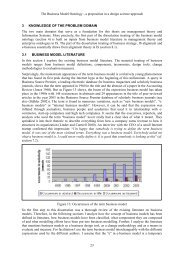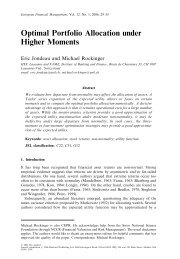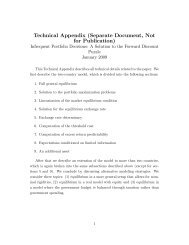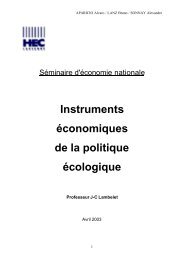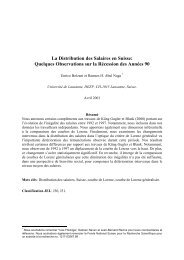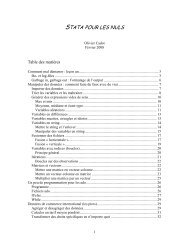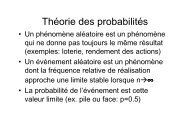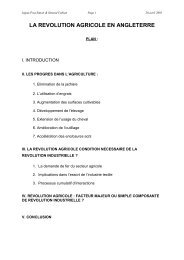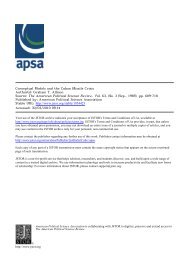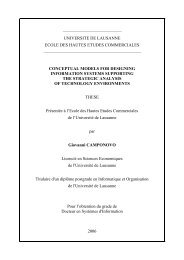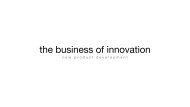DUCATI - HEC
DUCATI - HEC
DUCATI - HEC
Create successful ePaper yourself
Turn your PDF publications into a flip-book with our unique Google optimized e-Paper software.
<strong>DUCATI</strong><br />
By the end of 2000, Ducati had transformed from a company on the verge of bankruptcy into one of the<br />
most profitable motorcycle manufacturers in the world. Revenues had quadrupled since 1996; EBITDA<br />
had grown from 33 million Euros in 1997 to 60 million in 2000; Ducati’s market share had gone from 5%<br />
in the sport bike segment in 1997 to 6.7% in 2000. Analysts generally considered that a goal of 10%<br />
market shares within the next few years was reachable.<br />
Within the company, however, a question kept coming back: What should the company do next? Was<br />
doing nothing an alternative for Ducati? If not, should they attack Harley Davidson’s niche?<br />
The market for motorcycles in 2001<br />
Products<br />
1.6 million motorcycles were sold around the world in 2001. The market was divided into four segments:<br />
off-road, cruisers, touring and sport bikes. Off-road were designed for both on-road and off-road use and<br />
were characterized by a specific ergonomics to accommodate this dual use. The largest players within the<br />
off-road segment were the Japanese manufacturers. Cruisers were big motorcycles with an upright riding<br />
position. Their design emphasized styling over comfort and speed, and was preferred by many American<br />
riders. Harley-Davidson dominated this segment, while Japanese companies such as Honda, Yamaha,<br />
Suzuki, and Kawasaki imitated the traditional Harley style. In 1997, BMW introduced its own<br />
interpretation of a cruiser, which enjoyed a stunning commercial success. Touring bikes were larger<br />
motorcycles equipped for longer rides and greater comfort. BMW, Harley-Davidson and Honda<br />
controlled this segment. Sport bikes had lighter frames, a more forward seated position, and emphasized<br />
speed, acceleration, and minimal comfort. This niche could be further disaggregated into four subsegments:<br />
hyper sport (extreme performance, close to real racing machines), super sport (high<br />
performance, good handling and low weight), naked (good performance and urban riding) and sport<br />
touring (speed and handling, married with comfort for longer rides). Japanese companies dominated this<br />
niche, while European firms such as Ducati, BMW, and Triumph also vied for market share. Harley-<br />
Davidson entered the sport bike market by acquiring Buell Motorcycles in 1998. This segment was<br />
Ducati’s reference market.<br />
Customers<br />
A wide variety of inviduals, with very different tastes (and also differed by age, income, education,<br />
gender), bought motorcycles, from racing fans to week-end riders (who associated motorcycles with a<br />
certain life style). A large portion of ‘undecided bikers’ preferred more balanced and versatile bikes. The<br />
median age for a Harley-Davidson customer in 2000 was 46, while most Ducati buyers, ranged between<br />
25 and 35 years old (and was constantly decreasing over the years, while it was increasing for Harley).<br />
Women had become an attractive new customer base for motorcycle manufacturers, and were particularly<br />
important to some manufacturers like Harley and Ducati. Harley’s proportion of female buyers had<br />
increased from 2% in 1987 to 9% in 2000. Ducati claimed that women were attracted by the low seat<br />
height and weight of its motorcycles and accounted for 8% of sales of its most popular bikes, the<br />
Monster.<br />
1
Advertising happened essentially through specialized press. Motorcycle firms also gained media coverage<br />
by participating in racing events. In addition, movies brought cachet to motorcycles (especially<br />
Hollywood movies such as Easy Rider with Jack Nicholson and Peter Fonda).<br />
Technology and R&D<br />
Since its introduction at the end of the 19 th century, motorcycles’ comfort, performance, reliability and<br />
ease of maintenance had improved vastly. In the more recent periods, both engine innovations and<br />
improvements in pain, chrome and exhaust pipe shaping were introduced by manufacturers to appeal<br />
customers. Starting in the 1970s, the most important trend had been the progressive introduction of<br />
electronic components. More recently, advances in materials science led companies to introduce<br />
composites, titanium and magnesium to make their bikes lighter and more reliable. In-house R&D<br />
expenditures ranged between 2% and 5% of sales.<br />
Since the early 80s, companies such as Honda, Kawasaki, Yamaha and Ducati had also used racing<br />
competitions to develop technical solutions and test materials, and eventually transferred effective<br />
solutions to their production series. The racing circuit encompassed many competitions, the most<br />
important being the Grand Prix (125cc, 250cc and 500cc categories) and the Superbike Championship<br />
(with bikes ranging from 750cc to 1000cc).<br />
Manufacturing<br />
Most motorcycle companies invested heavily to automate production lines and worked with parts<br />
suppliers to improve quality and delivery. Only a few firms such as Triumph in 2000 outsourced around<br />
60% of its production. Many outsourced a considerable portion of their inputs, and therefore had very<br />
flexible production structures. Outsourcing minimized fixed asset investment, but the quest for quality,<br />
reduced costs and responsiveness to market fluctuations forced final assemblers to create strong<br />
commitment at the level of suppliers (Harley-Davidson was one of the leaders of this). The production<br />
had thus essentially become an assembly line where motorcycle components were assembled.<br />
Distribution<br />
All companies had some presence in the three major markets: United States, Europe and Japan. Their<br />
typical distribution systems comprised two types of agents: wholesale distributors and retailers.<br />
Depending on the strategic importance of the area, they used independent, partly, or totally owned<br />
wholesale distributors (subsidiaries).<br />
The size of the network, and therefore the degree of penetration into the market, were largely a function<br />
of the company’s strategy. Large Japanese mass-producers such as Honda and Yamaha, tended to<br />
maximize penetration, while companies such as Harley, BMW or Ducati emphasized the quality of the<br />
dealer and, where possible, used single-franchise agreements. This allowed them to control prices and<br />
brand positioning by allowing direct communication with customers. The most extreme case was Harley-<br />
Davidson, which had single-franchise agreements with the majority of its dealers (about 600 dealers in the<br />
US) and was really working on developing dealership loyalty.<br />
Competitors<br />
Over the 20 th century, the number of motorcycle manufacturers had decrease dramatically. In 2001, there<br />
was one major American manufacturer, four Japanese manufacturers and a handful of European firms<br />
(see Exhibit).<br />
2
Harley-Davidson – Harley was the major US manufacturer and dominated the US heavyweight (> 650<br />
cc) market. In 2000, it achieved its fifteenth consecutive year of record revenues and net income,<br />
increasing the former by 18.5% to $2.2 billion and the latter by 30% from 1999. Since going public in<br />
1986, its stockholders had realized a compound annual growth rate of over 40%, and Harley Davidson<br />
was the most profitable motorcycle manufacturer in the world.<br />
It produced 205,000 motorcycles, a 15% increase over 1999 (in addition, Buell sold 10,200 motorcycles a<br />
year). Its parts and accessories businesses made strong gains in 2000, with increases in revenues of 24%<br />
and 14% respectively over 1999. Relative to other manufacturers, Harley had a smaller global presence<br />
and kept a strong focus on the US market. Its presence in Europe was, however, increasing.<br />
Harley was considered as the typical example of a lifestyle company. In the US, particularly, it was a<br />
social and cultural phenomenon embodying values such as freedom and rebelliousness, and representing<br />
the history of motorcycle. The Harley brand was the strongest in the country. Harley sold 23 models, with<br />
prices ranging between $6,000 to $20,000 (with an average price of $14,000).<br />
Honda - With 5.4 million bikes produced (including scooters and small bikes), Honda was the world<br />
largest manufacturer of motorcycles. The company shared technology, engineering capabilities,<br />
marketing, distribution and know-how with its automobile division. It competed in all segments of the<br />
industry, and had a strong reputation for reliability and technical excellence. With its capabilities in fourstroke<br />
technology, Honda also led the industry in producing motorcycles and scooters utilizing low<br />
emission, fuel-efficient engines. Honda entered the US market in 1959, and had prices ranging from<br />
$5,000 to $19,000 (with an average price of $9,300).<br />
BMW – One of the top European automakers, BMW had been in the motorcycle business since 1984. It<br />
was the strongest European competitor in the US market, where it was growing. Its bikes had introduced<br />
several technical innovations such as advanced suspension systems, fuel injection, and anti-lock brakes,<br />
giving the brand a reputation for exceptional quality, reliability and comfort. The US average price of<br />
BMW motorcycles was $14,500, ranging from $8,000 to $20,000.<br />
Other Japanese manufacturers – In 2001, the other three Japanese manufacturers held a market share of<br />
57% of Ducati key market. Yamaha, Suzuki and Kawasaki entered the US motorcycle market in the<br />
1970s by selling small motorcycles. They then moved to the heavyweight segment. In Europe, Suzuki had<br />
a larger market share than Honda. In Asia, Kawasaki trailed only Harley and Honda. These companies<br />
competed on technological innovation and price.<br />
Ducati<br />
Ducati was founded in 1936 and its first bike, “il Cucciolo” became a blockbuster after the second world<br />
war. Followed several highly sophisticated and powerful models, all based on innovative engine systems.<br />
Thanks to this technical superiority, Ducati motorcycles rapidly achieved success in international racing,<br />
which fueled the company’s growth among sport-oriented customers and built a strong reputation for high<br />
performance. In spite of this, Ducati declined in the 1980s, was sold to Cagiva, regained momentum for a<br />
while, but faced important financing problems in the 1990s. In 1996, the company was one step from<br />
going bankrupt and was acquired by a private equity firm. The main partner had a passion for high-end<br />
businesses and was driven by the firm belief that Ducati had an enormous unexploited potential. To<br />
realize this potential, he hired a high profile new management team.<br />
The new management found three things at Ducati when it arrived:<br />
- good products: unique and beautiful bikes, even though regarded as less efficient and reliable than the<br />
Japanese<br />
- top-notch engineers: both in R&D and for the racing division<br />
3
- a brand with a strong potential. In most European markets, Ducati’s brand recognition was the highest<br />
in the motorcycle industry.<br />
With these aspects in mind, the new team worked at Ducati’s turnaround.<br />
The first thing that the new team designed was an ambitious plan, called the ‘World of Ducati’, to support<br />
and develop the brand. This started with the decision to build a museum, in order to show that Ducati was<br />
more than a motorcycle company: a dream and a passion. Investments in the racing team were also<br />
implemented. This generated an important change: in 1996, the racing division spent approximately 3.9<br />
million Euros with almost no revenue; in 2000, it spent around 10 million Euros, but revenues increased<br />
to 7.9 million Euros. The racing team was also a sophisticated R&D laboratory, where new features were<br />
continuously created and tested, and then introduced (for some of them) in series road bikes. Ducati also<br />
organized many events which were great public successes, attracting thousands of motorcycles lovers.<br />
Other aspects of Ducati’s turnaround strategy included the organization of production, and more precisely<br />
the role of outsourcing. In 1996, about 80% of Ducati’s production activities were outsourced. In 2001,<br />
that number had climbed up to 90%, a number which was significantly higher than other motorcycle<br />
producers. This allowed Ducati to increase its productivity from 76 bikes per workers in 1996 to 87 in<br />
2000. The majority of Ducati’s suppliers were concentrated in a district in Italy (known as the “Engine<br />
Technology District”), in which about over 2,000 small and medium companies had created clusters and<br />
served many other companies including Ferrari, Maserati, etc.). This allowed for joint activities in R&D,<br />
purchasing, suppliers’ quality control, etc.<br />
Regarding distribution, Ducati originally distributed its motorcycles through multi-franchise and<br />
independent dealers. The decision was made in 1997 to take more control of the distribution, especially in<br />
strategic markets. Subsidiaries were established in France, Germany, Japan, the UK and Holland, and a<br />
chain of mono-franchise dealers was created. Distinctive characteristics of Ducati were displayed in these<br />
dealer stores. Investments were also made to increase the average quality of the dealers (competent sales<br />
force, good technical assistance, etc.) everywhere in the world. This came with a decrease in the number<br />
of dealers (for instance, from 165 to 65 in Italy). Annual registrations per dealers therefore increased<br />
significantly (from 14 to 150 per dealers).<br />
Finally, the company also invested heavily in R&D, especially in new design technologies, product<br />
development and human capital. R&D investments went from 3.2 million Euros in 1997 to 12.9 million<br />
Euros in 2000. This helped to reduce the time to market for new product launches. Ducati’s latest models<br />
were developed in 15 months versus 36 months in earlier periods. In 2001, Ducati’s team of engineers<br />
was reputed as one of the most expert and skilled in the industry. The R&D department operated in close<br />
collaboration with the racing division but also the marketing department.<br />
The turnaround strategy didn’t involve major changes in the firm’s pricing strategy (see Exhibit).<br />
The current situation<br />
Now that the company’s turnover seemed practically over, Ducati’s executives were considering other<br />
alternatives for growth. The one that was receiving the most attention was entering Harley’s niche: the<br />
cruiser market. With about 400,000 units sold in 2000, this was a very large segment in the industry. To<br />
develop a cruiser model, however, Ducati would need to make additional investments (evaluated to 17<br />
million Euros) and would incur additional costs (evaluated to 26 million Euros). Using Ducati’s L-twin<br />
engine, Ducati had in mind a line of vehicles that could directly attack Harley’s line, and which would be<br />
priced between $10,000 and $20,000.<br />
4
Exhibit 1 – Ducati’s products<br />
EXHIBITS<br />
Ducati products were present in several market segments: Hyper Sport, Super Sport, Naked, Sport<br />
Touring. In addition, Ducati was selling spare parts, accessories and apparel.<br />
Hyper Sport: The company offered two basic models there in 2001: the 996 and the 748, each produced<br />
in three different versions. The 996S was Ducati’s flagship motorcycle and sold for $21,895 and<br />
contributed for 43% to the total revenues generated by motorcycles.<br />
Super Sport: The first Ducati Super Sport bike was launched in 1973 and remained for a long time<br />
Ducati’s most popular product. A new version, with a very futuristic design, was launched in 1998.<br />
Naked: Ducati’s naked motorcycle was called The Monster. It quickly became a very popular bike and<br />
the number of models in this family had been continually increasing since 1996 (with prices ranging from<br />
$6,000 to $13,000).<br />
Sport Touring: These motorcycles offered a more comfortable riding position than most other Ducatis.<br />
Different from other Ducati’s products, the number of Sport Touring models had not increased since<br />
1997.<br />
Sparte parts, accessories and apparel: All of this production was outsourced to two Italian companies.<br />
Many more spare parts were made available and distribution was improved, resulting in a considerable<br />
increase in the contribution of these spare parts to total revenues. Accessories and apparel businesses had<br />
become particularly important. In 2001, only Harley Davidson had a higher incidence on revenues (12%<br />
of revenues for HD, against 6% for Ducati).<br />
Exhibit 2 – The world market for motorcycles: New registrations 1996-2000<br />
1996 1997 1998 1999 2000<br />
New registrations 935,000 1,111,000 1,261,000 1,463,000 1,566,000<br />
Ducati’s core<br />
Market (as a % of the total<br />
market)<br />
29.7% 30.3% 32% 32.7% 33.2%<br />
Touring market (as a % of<br />
total market)<br />
33% 33.9% 33.8% 33.8% 32.7%<br />
Exhibit 3 – Market shares of competitors in Ducati’s core market (the sport niche)<br />
Ducati<br />
Honda<br />
Kawa<br />
Suzuki<br />
Yamaha<br />
BMW<br />
Harley<br />
World Europe<br />
1996 1997 1998 1999 2000 1996 1997 1998 1999 2000<br />
3.9 5.1 6.2 6 6.7<br />
4.3 5.2 6.5 6.4 7<br />
23.3 24.7 23.5 21.4 21.5<br />
23.8 25.8 24.2 21.5 22.7<br />
16.3 15 15.7 15.8 13.4<br />
15 15 15.3 15.8 12.3<br />
23.8 24.4 22.1 22.1 23.8<br />
24.5 24.1 21.3 21.9 23.5<br />
18.5 17 19 21.2 20.6<br />
21.3 18.7 18.4 21.8 22<br />
5.1 4.8 4.7 4.6 3.5<br />
5.8 5.4 4.8 4.8 3.6<br />
5.8 4.8 3.8 3.3 3.3<br />
1.5 1.2 1.2 1 1<br />
5
Exhibit 4 – A map of the market<br />
Knee down<br />
riders<br />
Fast riders<br />
Performance<br />
Urban riders<br />
Function<br />
Weekend<br />
cruisers<br />
Easy riders<br />
Lifecycle<br />
Highway<br />
lovers<br />
Exhibit 5 – Presence in different segments<br />
Ducati<br />
BMW<br />
Harley D.<br />
Honda<br />
Kawasaki<br />
Suzuki<br />
Yamaha<br />
Exhibit 6 – Customer profile<br />
Sex<br />
Age range<br />
Comfort<br />
Off road Cruiser Touring SPORT<br />
Hyper sport Super sport Sport touring Naked<br />
Ducati hyper Ducati super Ducati sport<br />
sport<br />
sport<br />
touring<br />
98% male 99% male 98% male<br />
62%: 18-35 64%: 18-35 73%: 31-43<br />
Ducati naked Harley<br />
Davidson<br />
96% male 91% male<br />
66%: 18-35 45.6 (median)<br />
Exhibit 7 – Ducati price premium vs. comparable products (average % premium per family)<br />
1997<br />
2001<br />
Hyper sport Super sport Sport touring Naked<br />
31.2%<br />
31.4%<br />
8.03%<br />
7.2%<br />
29.97%<br />
20.4%<br />
13.27%<br />
13.03%<br />
6
Exhibit 8 – Cost structure (% total revenues)<br />
Motorcycle materials a<br />
Related products<br />
Direct personnel b<br />
Indirect personnel<br />
Total<br />
R&D c<br />
Variable sales costs d<br />
Fixed sales costs e<br />
Administration<br />
Ducati 2000 Ducati 1996 Harley-Davidson<br />
43.4<br />
6.9<br />
5<br />
3.7<br />
59<br />
1.1<br />
5.9<br />
14.5<br />
4.7<br />
55.8<br />
2.2<br />
6<br />
4.2<br />
68.2<br />
0.1<br />
5.1<br />
10.4<br />
5.3<br />
Total<br />
26.2<br />
20.9<br />
a<br />
Includes parts, accessories and apparel (16.6% of total revenues in 2000)<br />
b<br />
Inbound logistics, quality management and operations<br />
c<br />
Part of Ducati’s R&D costs are capitalized (2.7% revenues)<br />
d<br />
Distribution, dealer bonus and warranties costs<br />
e<br />
Sales, marketing and after sales department costs, advertising, events, racing costs, subsidiaries costs<br />
Exhibit 9 – Ducati: Selected financials<br />
Total revenues<br />
Gross profit<br />
Other operating income<br />
SG&A<br />
EBITDA<br />
D&A<br />
EBIT<br />
Net income<br />
Market share<br />
45<br />
8<br />
6.4<br />
4.5<br />
65.9<br />
1997 1998 1999 2000 2001<br />
(estimates)<br />
195.63 240<br />
294.5 379.5 422.1<br />
74.57 91.71 118<br />
150.5 165.9<br />
0.53 1.18<br />
4.1<br />
4.9<br />
7<br />
41.7 52.4<br />
71.3<br />
95.4<br />
103<br />
33.4 46.49 50.8<br />
60.03 69.9<br />
16.7<br />
16.37<br />
2.7<br />
5.1<br />
19.17<br />
27.32<br />
(1.24)<br />
6.2<br />
24.4<br />
26.4<br />
8.9<br />
6<br />
29.6<br />
30.4<br />
10.5<br />
6.7<br />
2<br />
6<br />
5<br />
3<br />
16<br />
32.8<br />
37<br />
13.4<br />
7<br />
7


